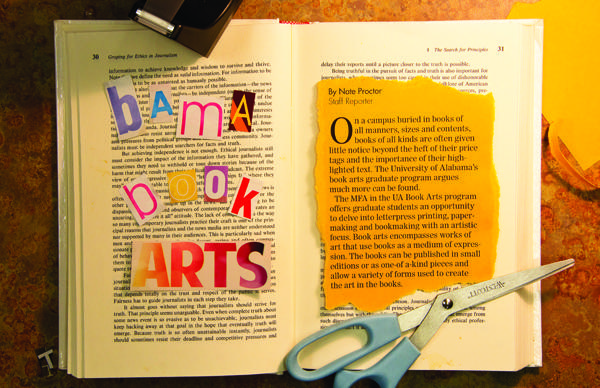On a campus buried in books of all manners, sizes and contents, books of all kinds are often given little notice beyond the heft of their price tags and the importance of their highlighted text. The University of Alabama’s book arts graduate program argues much more can be found.
The MFA in the UA Book Arts program offers graduate students an opportunity to delve into letterpress printing, papermaking and bookmaking with an artistic focus. Book arts encompasses works of art that use books as a medium of expression. The books can be published in small editions or as one-of-a-kind pieces and allow a variety of forms used to create the art in the books.
Steve Miller, professor and coordinator of the book arts program, first interacted with the art as a young poet living in Wisconsin.
“The moment that I took a proof of a poem that I had set in metal type on blue jean paper, from my jeans, that I had made in by hand,” Miller said. “In that moment it was like I had been struck by lightning. Every part of me was on fire.”
After printing his first poem in 1975, Miller practiced the art of letterpress printing in Madison, Wis., for three years before moving his shop to NYC where he worked with a variety of artists and writers for nine years.
In 1988 The University of Alabama called upon him to become an instructor in their young BFA in the Book Arts graduate program, the first of its kind. He accepted the offer.
The program, teaching book binding, letterpress printing, papermaking and the history of the book, sets a foundation for the artistic endeavors of their students, Miller said.
“If you learn the techniques of bookmaking, of book binding, of letterpress printing, then you’re free to be creative,” Miller said. “Then you can deploy those without thinking, they become a part of your body.”
He said the more his students learn of the intricacies of bookmaking, the broader their aspirations can become. Additionally, he spoke about his instructors’ efforts and his personal mission to maintain a strong presence in the bookmaking community at-large and facilitate post-graduate opportunities and connections for their students.
“We’re pushing you out,” Miller said. “You think you’re coming to Alabama for the graduate program, but in fact, my job is to get you out into the world.”
The strength of the University’s program has attracted a wide variety of mature and focused students, Miller said.
Claire Siepser came to the book arts program from Reed College in Portland, Ore. Though Siepser said her mother would claim a book made from a shoe during the first grade led to her eventual interest in book arts, Claire attributed classes during her junior year of college as her first introduction to the art.
“I want to make things, teach and help people express themselves,” Siepser said. “There’s something grounded about working with [the medium].”
She spoke about a growing art that originated out of printing machinery many thought to be becoming defunct.
“Whenever there’s an advance forward people want to hold onto the past,” Siesper said. “A book is making a world, a small installation that people can have a very personal experience with, and that kind of intimacy is rare.”
Amy Pirkle, who graduated from the book arts program in 2007, now creates book art and acts as an instructor for the undergraduate book art programs at UA.
Once a painter, she fell for the art, which combined her passions for art and books while studying abroad in Italy through Mercer University.
“I’m never quite as satisfied in completing any other project as I am completing a book,” Pirkle said. “I feel I’m creating work that means more.”
She said her classes, UH-210 honors fine arts designated, act as an introduction to book arts, teaching mechanical, artistic and historic basics to students.
“I think it’s an important medium,” Pirkle said. “It’s one thing to be able to make a photograph, but another thing to make a book. There’s such an intimacy.”
Pirkle believes the field will grow as more artists pop up and critical theory to correspond. Miller shared this thought, citing the growth of book arts organizations he’s affiliated with and more artisans popping up around the state and the country.
“It’s definitely on the rise,” Miller said. “There’s no reason for me to believe that we won’t keep blasting forward and more and more people won’t keep getting bit by the bug of hand-making books.”









